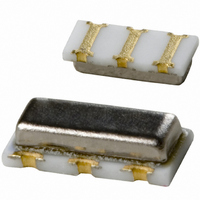CSTCR4M00G53Z-R0 Murata Electronics North America, CSTCR4M00G53Z-R0 Datasheet - Page 13

CSTCR4M00G53Z-R0
Manufacturer Part Number
CSTCR4M00G53Z-R0
Description
RESONATOR 4.00MHZ CERAMIC INDUST
Manufacturer
Murata Electronics North America
Series
CERALOCK®, CSTCRr
Type
Ceramicr
Specifications of CSTCR4M00G53Z-R0
Frequency
4MHz
Features
Built in Capacitor
Frequency Stability
±0.2%
Frequency Tolerance
±0.5%
Impedance
60 Ohm
Capacitance
15pF
Operating Temperature
-40°C ~ 125°C
Mounting Type
Surface Mount
Package / Case
3-SMD, Non-Standard
Size / Dimension
0.177" L x 0.079" W (4.50mm x 2.00mm)
Height
0.045" (1.15mm)
Lead Free Status / RoHS Status
Lead free / RoHS Compliant
Other names
490-1217-2
Available stocks
Company
Part Number
Manufacturer
Quantity
Price
Company:
Part Number:
CSTCR4M00G53Z-R0
Manufacturer:
MURATA
Quantity:
240 000
Note
• This PDF catalog is downloaded from the website of Murata Manufacturing co., ltd. Therefore, it’s specifications are subject to change or our products in it may be discontinued without advance notice. Please check with our
• This PDF catalog has only typical specifications because there is no space for detailed specifications. Therefore, please approve our product specifications or transact the approval sheet for product specifications before ordering.
sales representatives or product engineers before ordering.
Generally, basic oscillation circuits can be grouped into
the following 3 categories.
① Use of positive feedback
② Use of negative resistance element
③ Use of delay in transfer time or phase
In the case of ceramic resonators, quarts crystal
oscillators, and LC oscillators, positive feedback is the
circuit of choice.
Among the positive feedback oscillation circuit using an
LC, the tuning type anti-coupling oscillation circuit,
Colpitts and Hartley circuits are typically used.
See Fig. 2-6.
In Fig. 2-6, a transistor, which is the most basic
amplifier, is used.
The oscillation frequencies are approximately the same
as the resonance frequency of the circuit consisting of L,
C
and L
represented by the following formulas. (Refer to Note 3
on page 13.)
In an LC network, the inductor is replaced by a ceramic
resonator, taking advantage of the fact that the
resonator becomes inductive between resonant and anti-
resonant frequencies.
This is most commonly used in the Colpitts circuit.
The operating principle of these oscillation circuits can
be seen in Fig. 2-7. Oscillation occurs when the
following conditions are satisfied.
In Colpitts circuit, an inverter of θ
it is inverted more than θ
feedback circuit. The operation with a ceramic resonator
can be considered the same.
(Colpitts Circuit)
fosc. =
(Hartley Circuit)
fosc. =
2. Basic Oscillation Circuits
L1
and C
Loop Gain G = α・β ≧ 1
Phase Amount
2
in the Hartley circuit. These frequencies can be
θ = θ
L2
in the Colpitts circuit or consisting of L
1
1
+ θ
C
1
C
L1
L1
2
+ C
· C
= 360°×n (n = 1, 2,…)
L2
L2
2
= 180° with L and C in the
1
= 180° is used, and
1
(2-4)
(2-5)
(2-6)
Fig. 2-6 Basic Configuration of LC Oscillation Circuit
Colpitts Circuit
Principles of CERALOCK
C
L1
Fig. 2-7 Principle of Oscillation
L
C
L2
Amplifier
Feedback Circuit
Feedback Ratio :
Phase Shift :
1
2
Oscillation Conditions
Loop Gain G= α · β ≧ 1
Phase Shift θ = θ
Hartley Circuit
L
1
C
L
2
1
+ θ
2
=360°×n
®
2
11
P17E.pdf
10.8.3
2






















